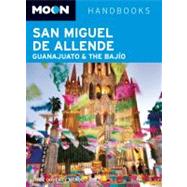Professional writer and longtime Mexico resident Julie Doherty offers up the inside scoop on the Bajío, from where to sip a margarita in San Miguel to how to best explore Guanajuato on foot. Doherty also provides original trip itinerary ideas, including The Best of the Bajío, Art Lover's Tour, and Desert Chill. Complete with tips on the best museums, historic sights, shopping, and food in the region, Moon San Miguel de Allende, Guanajuato & the Bajío gives travelers the tools they need to create a more personal and memorable experience.








